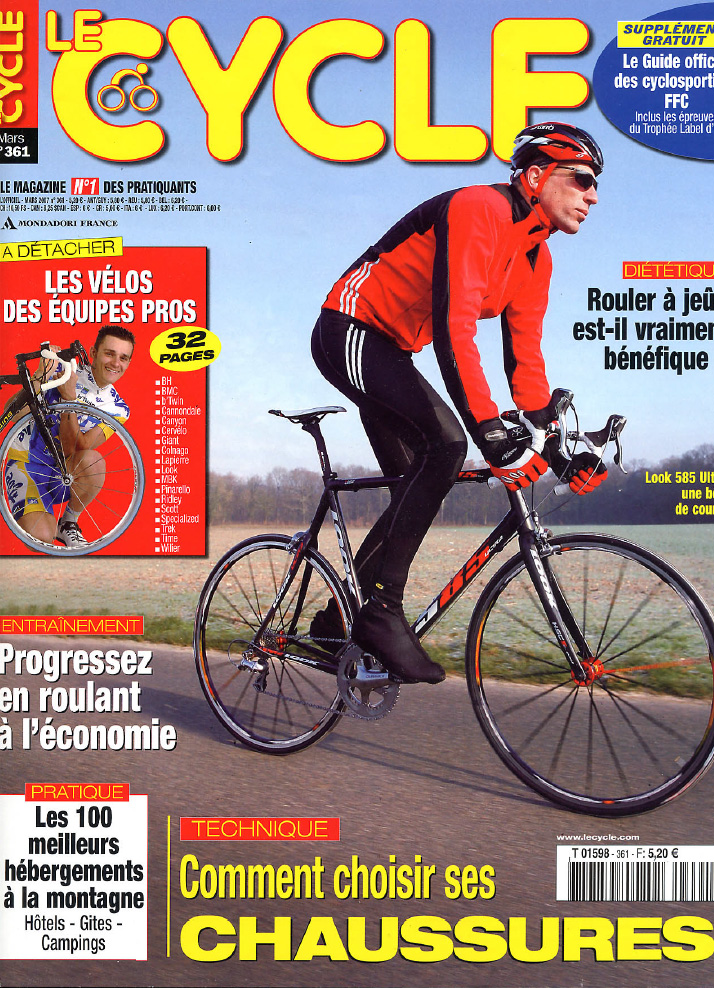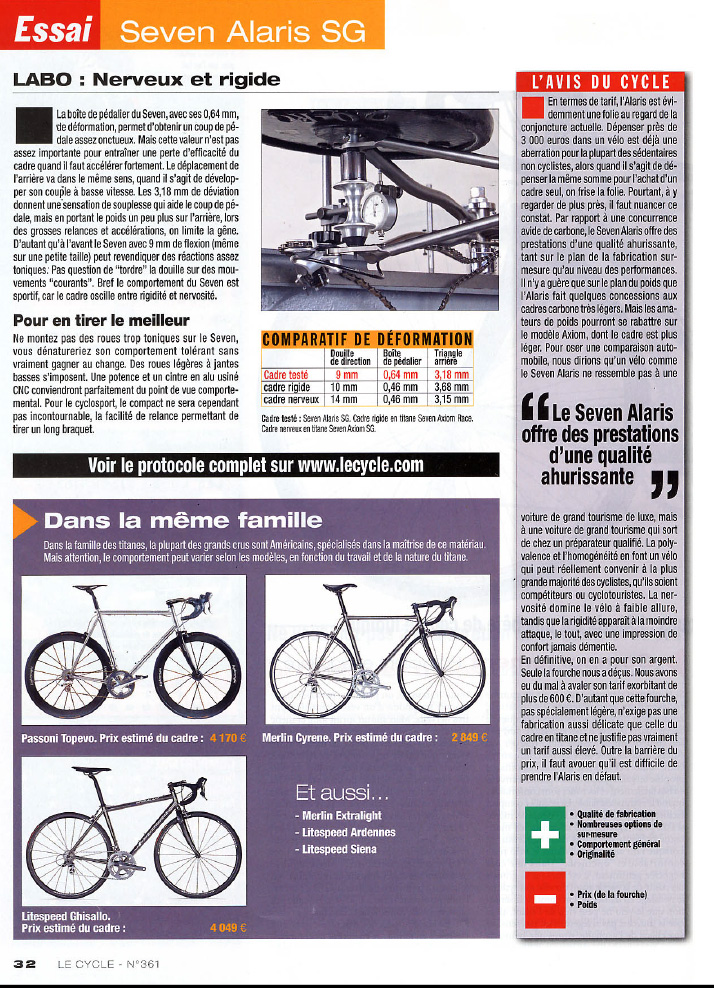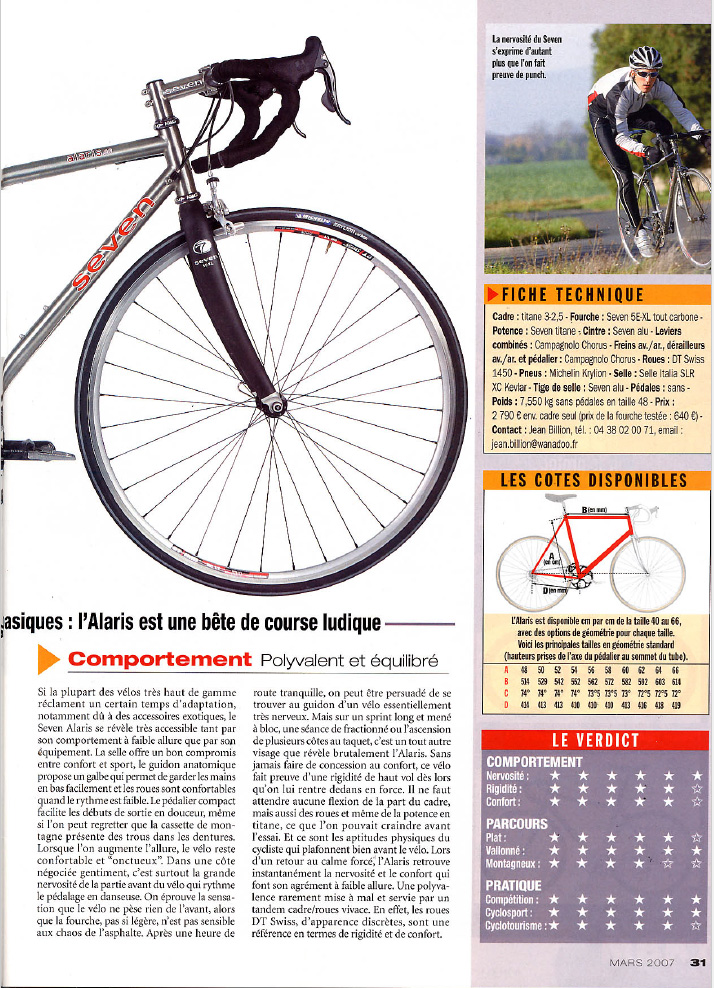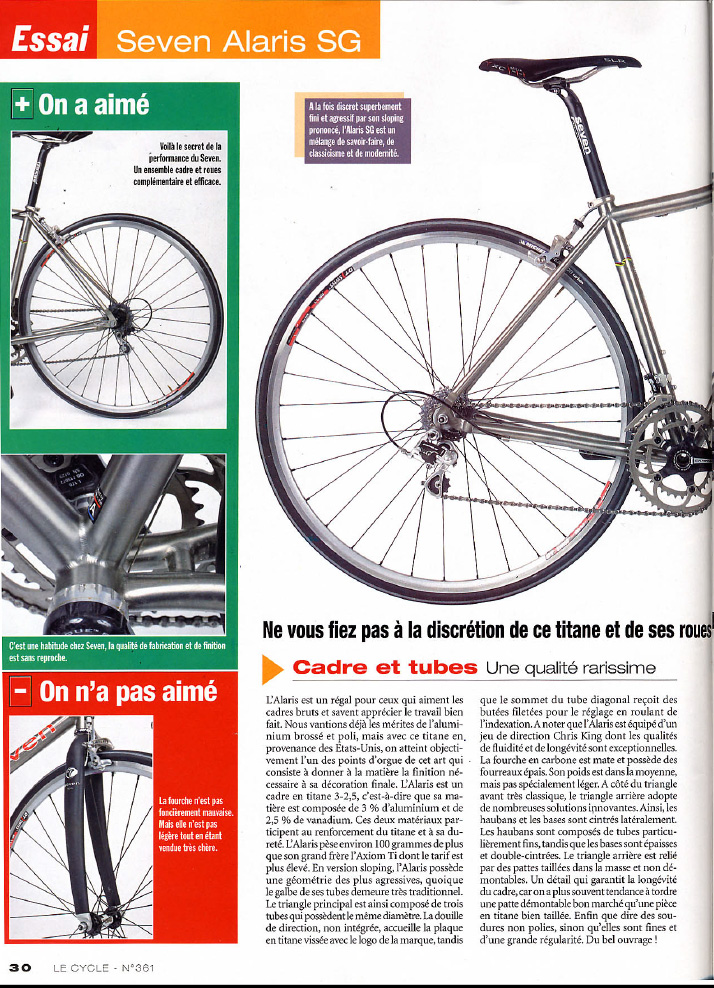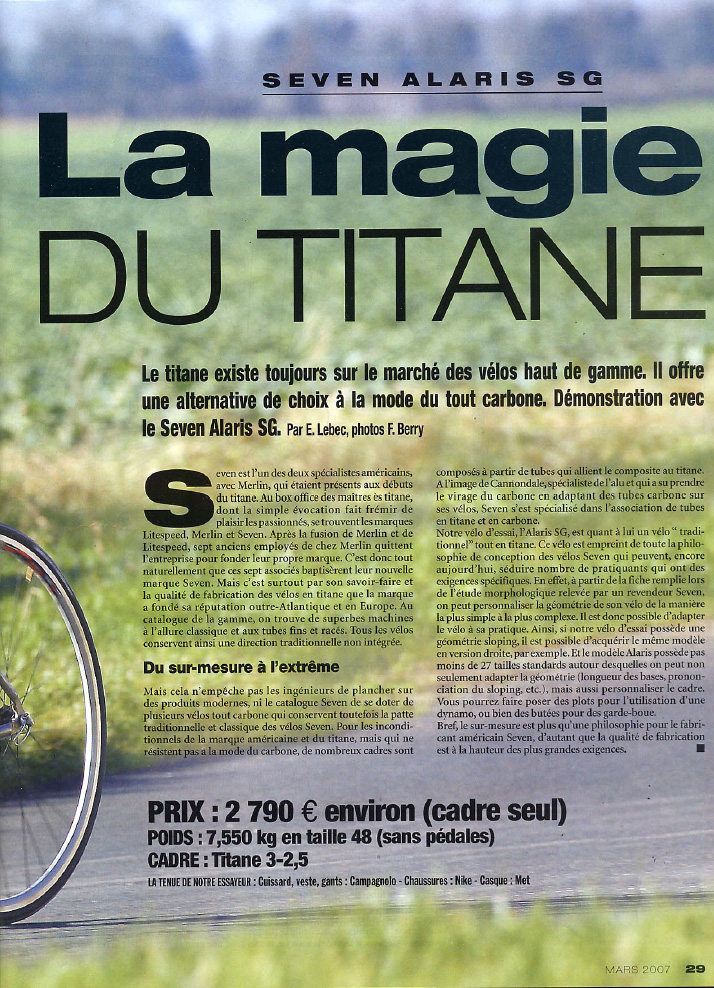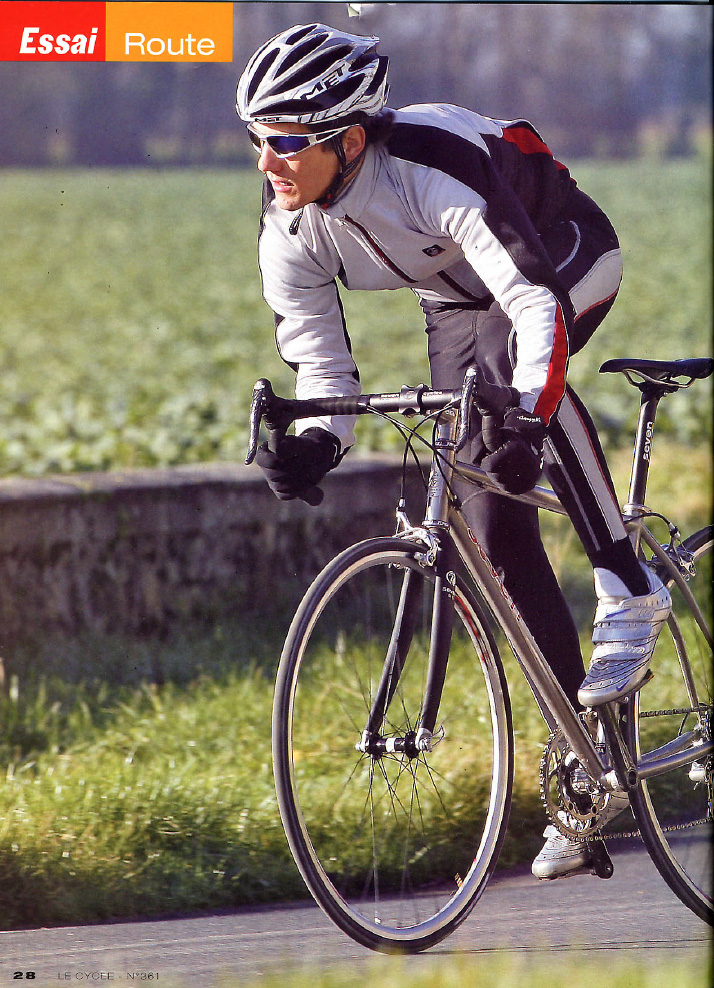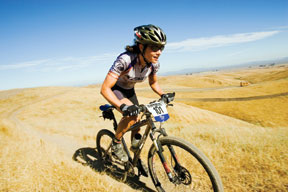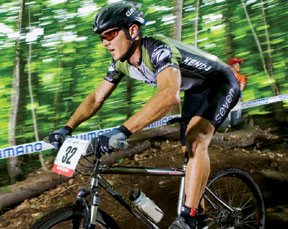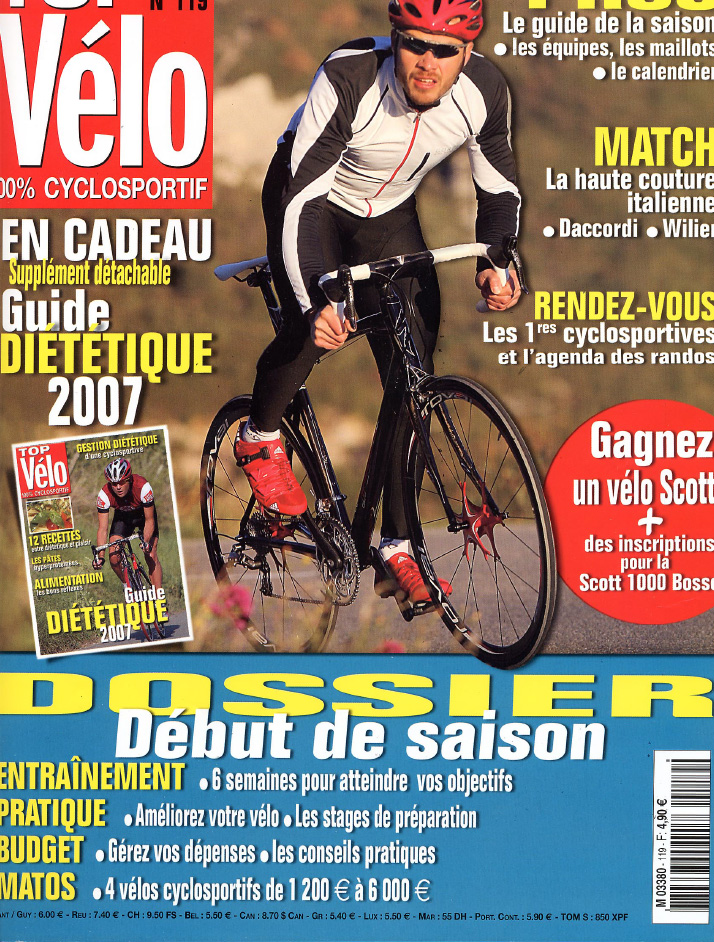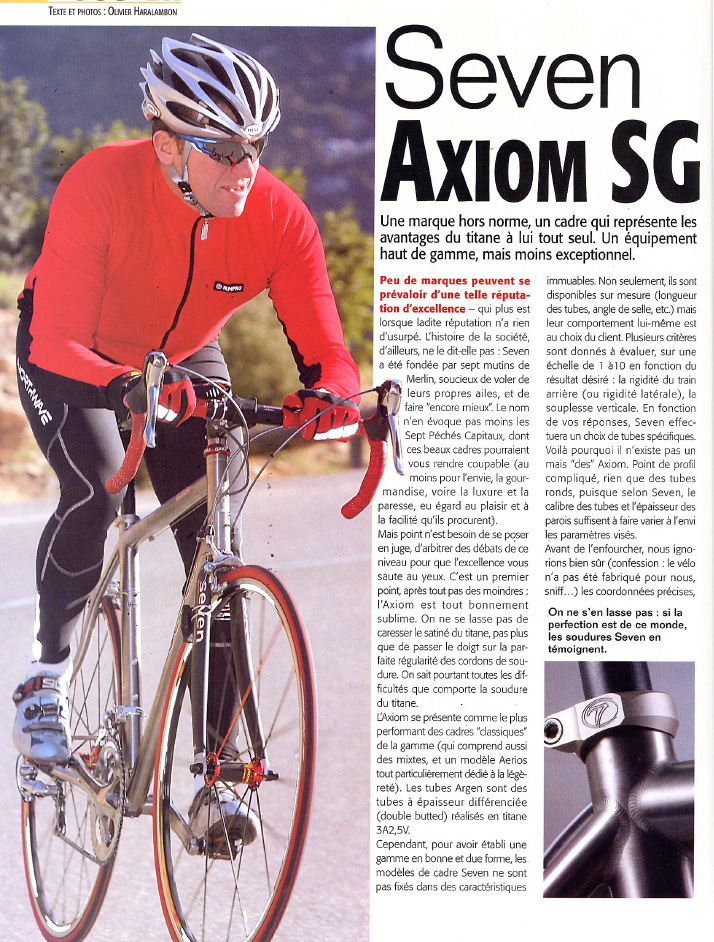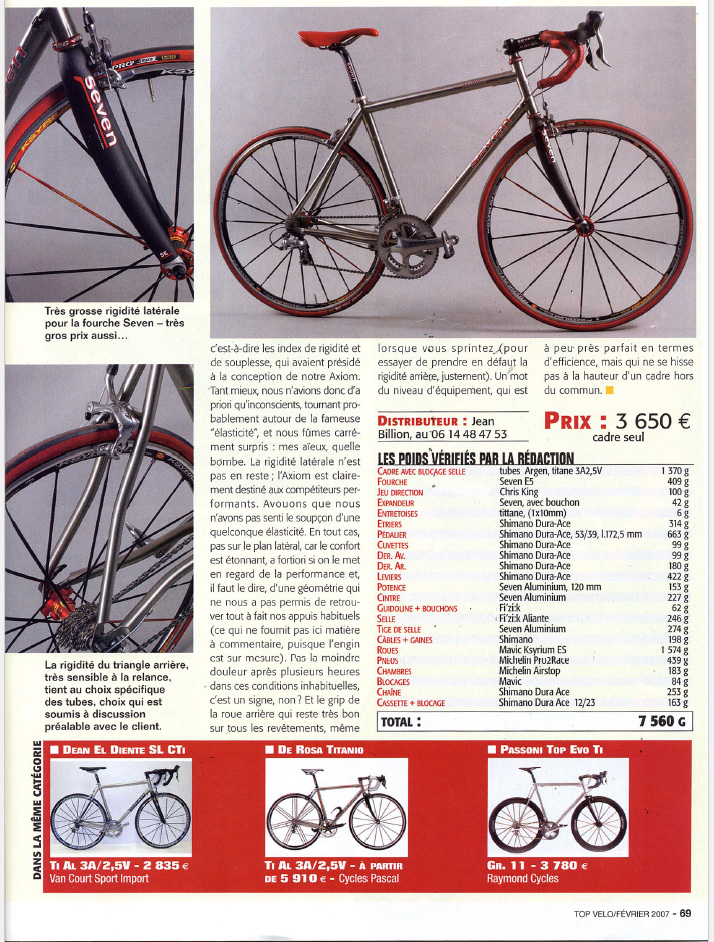Author: Seven
Seven’s McConneloug Takes Silver at Continental Championships
For the fifth consecutive year, team Kenda-Seven Cycles elite racer Mary McConneloug was selected to the U.S. national team to compete in the Continental Mountain Bike Championships, and for the fifth consecutive year she took home a medal—this year adding a silver to her collection. Mary is the U.S.’s top ranked racer and one of the most consistent finishers on the circuit.
Kenda-Seven Cycles’ Mike Broderick was also selected to the U.S. team. Mike showed impressive early season form to finish 10th in the Elite men’s contest.
The Continental Mountain Bike Championships took place in Nequen, Argentina on March 11. The United States Mountain Bike Team collected a total of eight medals in a major step toward securing the maximum number of start positions at the 2008 Olympic Games for the U.S.
The Continental Championships are important because of the amount of international ranking points available—the primary factor in determining how many start positions countries receive at the 2008 Games in Beijing. Entering Sunday’s race, the United States was ranked fourth in the men’s standings behind Switzerland, France and Spain, while the women were ranked sixth behind Norway, Germany, Canada, China and Poland. The U.S. must hold a final ranking in the top-five for men and top-four for women on Dec. 31, 2007 to accumulate the maximum number of Olympic start spots.
Congratulations Mary and Mike!
Top Velo Magazine (France): Seven Axiom SG
Los Angeles Times: A bicycle built for you; Stability, handling, comfort—all in a life-changing package.
by Bill Becher
Southern California roads are full of them—cyclists shrink-wrapped in colorful Lycra, pedaling custom bicycles that cost more than their first cars. And their numbers are increasing by the day.
People who’ve only ridden an old Schwinn cruiser on a bike path at the beach can find it hard to fathom riders’ willingness to happily drop $8,000 or more on rolling titanium and carbon fiber sculptures. They tend to dismiss it as a manifestation of the Southern California must-have-more attitude: Why drive a Honda when you can take out a loan and buy a Mercedes?
But for those who spend weekends zooming along the Pacific Coast Highway wheel-to-wheel with other riders in a wind-cheating peloton or flying down a twisty canyon road in the Santa Monica Mountains, a custom bike is worth every penny.
“I’m in it for life,” says Bob Perkins, 54, explaining his decision to buy a custom bike. “I brush my teeth twice a day and try to ride my bike once a day.” The Simi Valley resident has the same feeling about his 17-pound titanium bike that a National Rifle Assn. member has for his Colt .44: He’ll never let it out of his hands.
Hard-core riders say it isn’t ego-driven bike lust that causes them to invest that kind of money in a bike. For them, it’s about comfort, efficiency and dialed-in handling. And if that kind of ride costs thousands of dollars, so be it.
“I can ride it 50 or 60 miles and know I can go more,” Perkins says of his custom-built bike from Seven Cycles. “With my old bike, the party would be over.”
After years of mountain-biking enthusiasm, road bikes are making a comeback. According to the National Bicycle Dealers Assn., the road bike market share has grown from 5% of bikes sold in 2002 to 16% in 2005. Much of that growth is in the sales of high-end bicycles, dealers say.
The trend may be part of the Lance Armstrong effect—the cancer survivor’s seven wins of the Tour de France brought road bike racing to the attention of the general public. But it’s more than that. Aging baby boomers with bad knees and the cash to spend on fancy bicycles are now taking up road cycling as a low-impact alternate to running for cardiovascular exercise.
While the average road bike costs about $1,200, serious riders can easily spend $4,000 to $10,000. Although stock bikes can cost that much, for many of the growing number of cyclists who think nothing of riding 50 or 100 miles on a Saturday, the custom-built bike is the only way to ride.
Almost any bike can be adjusted to the average cyclist’s shape to provide a more comfortable ride, but ordering a custom bike allows the buyer to specify ride qualities such as how the bike should handle and how stiff (for hill climbing) or comfortable the ride should be.
Minor changes in the bike frame’s geometry can have a profound affect on how the bike responds. Quickly and nimbly or slowly and steadily can be a matter of a few degrees difference in the angle of tubing. And of course, a custom bike is tailored to the rider’s body to fit like an Armani suit on Michael Jordan without sacrificing desirable ride qualities.
Michael Bright, 41, of Calabasas, spent eight days riding from San Francisco to Santa Monica last year. He says he wanted a bike that fit well and was comfortable to ride long distances. He achieved that goal with a $7,500 custom Serotta titanium and carbon fiber bike designed to be more compliant to soak up road bumps and fit right. “I don’t shift my weight an inch, I don’t fidget,” says Bright. “Once you have a custom frame, you won’t go back.”
Tailored to riding style
Two riders with identical measurements and weight can end up with very different frames, depending on what they want the bike to do.
“If one loves to sit and climb and the other guy is sprinter, you’d want the bike different for those people,” says custom bike builder and cycling author Lennard Zinn. “For the climber, you’d focus on light weight. You’d want the bike to be stable at speed for descending and slower turning—less twitchy. For the sprinter, weight wouldn’t be as critical, but lateral stiffness would be a really big deal and you’d want it quicker turning.”
Building a custom bike is a technologically advanced and labor-intensive process.
“It’s more akin to car manufacturing. It’s not two guys in a basement making custom bikes,” says Rob Vandermark, founder and president of Seven Cycles, the 10-year-old Massachusetts company that made Perkins’ bike frame. The company’s bike frames start at $1,700 for a custom steel frame and cost about $3,200 for all- titanium models.
Materials for lightweight, high-end bikes are expensive—titanium and carbon fiber tubing costs eight times more than steel, the traditional material for bike frames. But then titanium, used to plumb nuclear reactors, is very strong and does not corrode. One cyclist jokes that the only way he can justify getting a new titanium bike is to “accidentally” back his car over the old one. Carbon fiber composites (the stuff used to build Stealth bombers) have come into favor as a bike frame material because of their high strength-to-weight ratio and their ability to soak up vibration. Until recently, most carbon frames were built in stock sizes because of fabrication complexities. Now bike builders have found ways to make custom carbon fiber frames, but the cost can be steep. One carbon fiber frame model from Serotta Competition Bicycles, builder of bikes for Tour de France riders, costs $7,000, although lower cost carbon frames are available from Serotta and other companies. Some bikes combine titanium and carbon fiber tubing.
Whatever material a rider chooses, buyers of a Seven Cycles custom bike, for example, spend several hours at a dealer being measured and filling out a two-page questionnaire on what riding characteristics they want, existing injuries and any pain they experience when riding. The company then compares the responses with information in its database of more than 16,000 riders and follows up with customers as necessary.
Vandermark reviews all bike designs before they are built. Once a buyer signs off on the design, the data are used to produce a “build sheet” that specifies what tubing is to be used and how it will be cut and assembled. Tube thickness is modified to create the desired ride—thicker for stiffness, thinner for comfort. Welding a titanium bike frame is a slow process, with frequent stops to check the frame’s alignment. When a local dealer assembles the complete custom bike, the end result can change riders’ attitudes toward cycling, Vandermark says.
Riders have learned to accept pain and discomfort from riding an ill-fitting bike and think it’s part of the sport. But when they ride a custom bike—matched to their body and cycling style—the pain goes away. “It’s like if you had a headache for a few hours, you start to ignore it, but then you notice it when it goes away,” Vandermark says. “When it’s gone, it’s a wonderful thing. A custom bike takes care of all the things you’ve learned to ignore.”
Along with pain, riders on a stock bike may have to learn to live with the shortcomings of a bike that doesn’t handle well. “People say, ‘It’s a bike, it has two wheels, they’re skinny, what do you expect?’ ” says Vandermark. “But if a bike doesn’t handle well, that’s harder to ignore.”
Steve Dozier, co-owner of Sundance Cycles in Agoura Hills, which sells about 100 custom bikes a year, says the joy of a custom bike is more than ergonomics. Using a stationary bike called the Serotta Size Cycle designed expressly for determining bike fit, Dozier’s shop works with customers to position pedals, seat and handlebars in what he calls a virtual position in space.
“Then we design the bike underneath the rider,” says Dozier. “We put the wheels where they need to be. A small woman is going to need a shorter wheelbase, a bigger guy a longer wheelbase because ultimately what makes the bike handle properly is the weight distribution between the front and rear wheels.” Dozier says he can build a complete custom steel bike for about $3,000 for customers on a budget who don’t fit well on a stock bike because of disproportionately long (or short) legs or torsos.
Your bike, your way
Custom bikes are not just about fit and handling, Dozier says. As with customized boats and cars, they’re fun. “You get to make it your own,” he says.
The frame usually accounts for about half the cost of the complete bike. Along with paint scheme, custom bike buyers can choose wheels, gears, shifters, bars and other bike parts. Carbon fiber handlebars are stiff for sprinting but also help soak up road shock. Better drive train components improve shifting. Lighter wheels improve climbing performance. More aerodynamic wheels are heavier, but better for fast riding in the flats. Riders have been known to bring a postage scale into a bike shop and weigh different components looking to shave a few grams, but that costs money. While some might suggest skipping a meal can save weight, lighter bikes perform better in the hills.
Of course, some of what riders call “ELS”—expensive lightweight stuff—could be considered bike bling. A standard aluminum cage to hold a water bottle weighs 2 ounces and costs $12, but riders willing to spend $60 on a carbon fiber cage can save almost an ounce—about half the weight of an energy bar.
His custom Seven Cycles bike isn’t guy jewelry according to Perkins, who says he becomes one with his bike when he’s cycling through the Santa Monica Mountains. “Riding down a canyon the road feels like glass. All you hear is the air going by your ears—you’re free as a bird going as fast as you want.”
Road bike cyclists can follow these suggestions for a basic do- it-yourself fit session:
- Adjust bike cleats on your shoes until the balls of your feet are over the pedal axle and your toes and heels are in a straight line. If you have wide hips, move the cleats to the inside of the shoes so that your feet are wider apart on the pedals. If you have narrow hips, move the cleats out. If one leg is shorter than the other you may need to shim the cleat on the shorter leg.
- Set your bike on an indoor trainer and prop up the front wheel so the bike is level. Measure and mark the current seat height. Adjust the saddle to a dead level position using a carpenter’s level. Hop on the bike and pedal for about five minutes to loosen muscles.
- Stop pedaling and adjust the seat height until the heels of your unclipped bike shoes just graze the tops of the pedals when your legs hang fully extended. Mark the new seat height—this is where you want to end up but don’t make big changes in seat height all at once. Raise or lower the seat no more than about a quarter of an inch per week. If the front of your knees hurt during or after riding, your seat is likely too low. If the back of your knees hurt, the seat may be too high or you may have made too big of an adjustment.
- With your feet clipped into the pedals at the three and nine o’clock positions, have a friend use a string and weight such as a plumb bob to help position the seat fore and aft on its rails until the string hangs straight down from the indentation at the bottom of your kneecap to the pedal axle.
- With your body in the riding position, look down. If the handlebars hide the front wheel hub your reach is probably correct. If the hub is in front of the bars, you need a longer stem; if behind, you need a shorter stem.
- If your neck or back hurts when you ride, there’s a good chance that your bars are too low. Raise the bars until you are in a comfortable position; usually this means that the bars will be the same height as the seat or higher. Competitive cyclists like a low position for aerodynamic efficiency, but recreational riders will find raising the handlebars will be more comfortable.
- These suggestions are only a starting point. If you have chronic pain when cycling, get a professional bike fit.
(These tips assume you ride a road bike with drop bars, have access to an indoor cyclo-trainer and are using “clipless” pedals and cleats on your cycling shoes.)
Adventure Cyclist: Seven
Dan D’Ambrosio
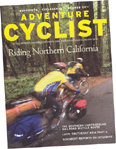
Jeff Peters both rides and sells Seven bicycles. The manager of Erik’s Bike Shop on the west side of Madison, Wisconsin, tells his customers that the bikes from Watertown, Massachusetts, which start at about $5,000 for a complete bike and head north from there, are actually a deal.
“I’ll look them straight in the eye and say, ‘I think this is one of the most exceptional values I have on the sales floor,'” Peters said recently.
To understand where Peters is coming from, one need only look at his own Seven, a Tsunami cyclocross bike that he bought about six years ago.
This fall, at the age of forty-two, Peters plans to enter his first cyclocross race on his Tsunami, which utilizes Seven’s proprietary Argen™ butted titanium tubing.
Two years ago, Peters took his Tsunami on a 4,000-mile tour from Green Bay to Nova Scotia and back. He took two months to do the solo tour, averaging about 2,000 miles each month and carrying all his gear in a BOB trailer, including a sleeping bag and tent for camping and a stove and utensils for cooking.
“I used to run panniers, now I run a BOB,” said Peters. “I like the (lack of) wind resistance. It pulls a little more on the hills, but especially for solo touring, it’s the only way to go.”
Peters said toward the end of his Nova Scotia tour he was anxious to see his friends again and rode 800 miles in the last ten days.
Now let’s turn to commuting.
Peters has been in the bike business for twelve years, managing Erik’s for the last year. He uses the Tsunami as a commuter for the twenty-mile round trip from his home to the shop, riding “ninety percent of the time all year long.”
Peters calls himself an “urban assault commuter” who takes every imaginable shortcut he possibly can. Through it all, the Tsunami, bred for cyclocross, shows no sign of fatigue.
Add it all up and you begin to see why Peters can tell customers with a straight face that a bike that costs more than many of their first cars is a bargain.
“A lot of people gasp at the price tag, and it definitely costs a little more, but look at the fatigue life of a really quality-built titanium frame,” said Peters. “It’s well into twenty or twenty-five years.”
On top of that, says Peters, titanium offers a comfortable ride without sacrificing performance.
“My bike was built to be smooth riding, yet when I stand on my cranks, I just go,” said Peters.
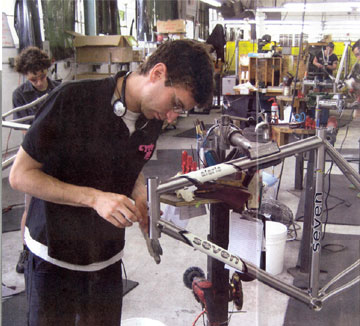
What sets the Seven apart from other titanium bikes, according to Peters, is the company’s “custom kit” fit form, a twelve-page booklet that might remind you at first glance of those forms you have to fill out every year and send to the Internal Revenue Service by April 15.
To say the custom kit is thorough would be an understatement. It begins with an explanation of the order process, which will take eighteen days before Seven is satisfied that it has enough information to select the tubeset that’s right for you and put your frame into production after creating a Computer Aided Design, or CAD, drawing of it.
Machining, welding, finishing, and painting your frame, if that’s required, will take another four to five weeks, with about sixteen hours of hand labor going into each frame—all of that for an average cost of $3,000 for a titanium frame or $1,600 for a steel frame.
After eight pages of exhaustive explanation of every aspect of bike design and manufacturing, from a discussion of sloping top tubes to directions for taking your body measurements, you’ll get to the four pages of data-gathering in Seven’s custom kit form.
There’s the usual height, weight, and inseam, but there’s also arm, lower leg, and forearm lengths, plus shoulder width and shoe size. Seven also gathers all of the data from your current bike, including top tube length, ground-to-saddle distance, and stem angle.
There is a series of questions, including “How would you rate your flexibility?,” on a scale that goes from “palms on the floor” to “can’t touch the floor.”
Seven asks if you experience lower back, upper back, or neck pain. They ask if your hands go numb. They ask you to describe your current bike’s handling and drivetrain rigidity, among other things.
After you select your model from among Seven’s road and mountain-bike offerings, you’re asked how you will use your new bike by assigning a percentage of rime to as many of fourteen categories of riding that apply. The categories range from “fun” to “touring: loaded,” and include club riding, stage racing, and commuting.
A separate form for ordering a mountain bike mirrors the road form, only with different categories, such as “technical singletrack” and “fire roads.”
Before signing your name to the form, you’re also asked to indicate on a scale of one to ten how you would like your Seven to ride. Should the handling be more stable or more agile? Should the “vertical compliance,” that is ride comfort, be comfortable or stiff?
Then there’s a space for notes, where you explain whatever wasn’t already covered by the form.
“There’s a lot of custom manufacturers out there that will provide geometry customized to each individual, but at Seven, you also tell them what you want to do,” said Peters. “They’ll take your measurements, but they’ll also call and talk to you for twenty minutes.”
When Peters filled out his form and had his conversation with Seven, he stressed comfort. The Nova Scotia ride was on the horizon, and Peters knew he’d be logging a lot of hours on his Tsunami.
“My first priority was comfort,” said Peters. “Doing a 4,ooo-mile tour, I’m spending six to eight hours a day on the bike. I’m not concerned about shaving a few seconds off my time. I’m going to be on the road sixty to eighty miles a day, not sleeping on a bed, but sleeping in a bag, pulled off wherever. I want something that’s going to be comfortable, built for my size and weight.”
Peters said he carries about seventy- five pounds of equipment when on tour.
“I take the whole kitchen sink with me,” he said.
The end result has more than satisfied Peters.
“It’s just the ride quality,” said Peters. “There are custom geometries out there, but nobody else who customizes the tube thickness to each individual. The Tsunami has such phenomenal ride quality and efficiency. I have eight bikes at home, but it’s hard for me to ride any other bike.”
All of which is music to Rob Vandermark’s ears and the fulfillment of the business plan he devised ten years ago when he launched Seven with three other people.
Vandermark’s involvement with bikes began early in Natick, Massachusetts, where he grew up. He wanted to do everything his big brother Ken did, so when Ken, now a jazz musician, became enamored with bikes for a “short period,” so did Rob. For Rob, the love affair never ended, it only intensified.
Vandermark entered the Massachusetts College of Art and then the School of The Museum of Fine Arts, both in Boston, to study sculpture.
“But I really loved being in the world, doing stuff,” said Vandermark. “I dropped out because I was so excited about making stuff people used.”
Like bikes, for example.
Vandermark, thirty-nine, joined Merlin, the titanium bike builder then based in Cambridge and now part of Litespeed in Chattanooga. Starting in the finishing department in September 1987 when he was twenty years old, Vandermark began by applying decals and doing other relatively menial tasks.
Within a year, the art school dropout, who already knew how to weld because of his sculpture background, was able to build frames.
“The environment was open and free,” said Vandermark. “I was trying ideas after hours, and that turned into a research and design job.”
Vandermark said he quickly realized that coming up with innovative designs was only part of the equation for being a successful bike builder.
“How do you make bikes, pay people well, and create a good value for the customer? That consumed me,” said Vandermark. “If you can’t make it, it doesn’t matter how cute it is.”
Vandermark spent almost ten years at Merlin, but by the end of his tenure, he said it was clear that Merlin wanted to grow and compete with titanium juggernaut Litespeed—ironic considering that ultimately Merlin would be consumed by Litespeed.
Vandermark decided to go it alone. He would take away from Merlin incomparable experience building titanium frames, and he’s be influenced by the pioneering work of Tom Kellogg, the man he says is still “one of my favorite people.” Vandermark gives Kellogg credit for laying the groundwork of Seven’s custom-kit fitting system.
“He’s just really thoughtful about bike fit and also able to fit someone through long distance,” said Vandermark. “He developed a system to do it from 2,000 miles away.”
Jennifer Miller, responsible for Seven’s market development, met Vandermark when she worked at Merlin, where she spent about five years in purchasing and operations management.
After leaving Merlin in the summer of 1996, Miller was contemplating a return to the financial services industry when she got a call from Vandermark.
“He wanted to create a company with a business model based entirely on custom design on a scale not done before and with a comprehensiveness that hadn’t been done before,” said Miller.
Dealers—Seven has about 200 of them in the United States and thirty international distributors—play a “critical role” in Vandermark’s scheme because of the importance of gathering accurate data from the customer, said Miller.
Founded in 1997, Seven turned a profit in only its second year in business. This year, the company will sell about 2,600 bikes, according to Miller, and has sold some 16,000,custom frames since its inception. Miller said the company is still growing, although she said it’s “not as easy as it used to be.”
On the eve of Seven’s launch in 1997, says Miller, a controversy arose over what to call the company. If it had gone another way, Seven riders would instead be riding “Vandermarks.”
“When we were first starting out we thought we would call the company Vandermark,” said Miller. “We were trying to leverage Rob’s reputation. In the eleventh hour, Rob says, ‘This isn’t about me.’ He felt awkward. It speaks volumes about Rob. He’s very modest.”
It was Miller who suggested the company be named Seven Cycles. She said the name has no negative connotations and the number seven is considered lucky, even internationally, which was important to a company that knew it wanted to sell overseas.
Also, there was a strict “no birds” rule—”no Merlins, no Ibises,” said Miller. And to dispel a rumor or two about the origin of the name, the company was founded by four people (there are ten times that number now), not seven. And while it’s true that everyone worked seven days a week in the beginning, only Vandermark still does, according to Miller.
Vandermark said ten to fifteen percent of the company’s production of 2,600 frames this year were touring frames, and he’d like to see the percentage grow. He sees the touring market as perfect for Seven because of the company’s focus on fit, function, and durability.
“In the road market, there’s an emphasis on form over function with a lot of interest in the way stuff looks,” said Vandermark. “It’s the reverse in the touring market. It’s got to work well, fit well, and be bulletproof. In a lot of ways, the touring market is the sweet spot for Seven. We can make it fit better and ride better.”
When price is not the primary consideration, Vandermark said titanium is the ideal frame material for a touring bike. It’s light, tough, and offers a plush ride, with no worries about the rust or oxidation that can come with steel and aluminum frames.
“Straight-gauge titanium is tough to beat,” said Vandermark. The Seven founder rules out carbon as a frame material for touring because of its vulnerability to damage. Something as simple as leaning your carbon bike against a wall and having it fall over in a breeze could spell disaster.
Vandermark rules out aluminum because—to get the strength required—you end up with a “really stiff’ frame. Seven does not build any aluminum frames.
When price is a consideration, Vandermark has no qualms about recommending steel—the old reliable. Seven offers a steel version of its Vacanza touring frame. The titanium Vacanza utilizes Argen™ butted tubing for a light but strong frame, whereas the Muse uses Seven’s Integrity 32S™ straight-gauge titanium tubing for “ultra-durability.”
“People here are really excited about touring bikes,” said Vandermark. “There’s a lot of support and appreciation for touring riders, people getting a bike to really ride. That’s cool, very cool.”
Dan D’Ambrosio is a newspaper reporter for the Waterbury Republican American in Waterbury, Connecticut. He is the former long-time editor of Adventure Cyclist. He will continue to contribute interesting profiles to the magazine in the future.

